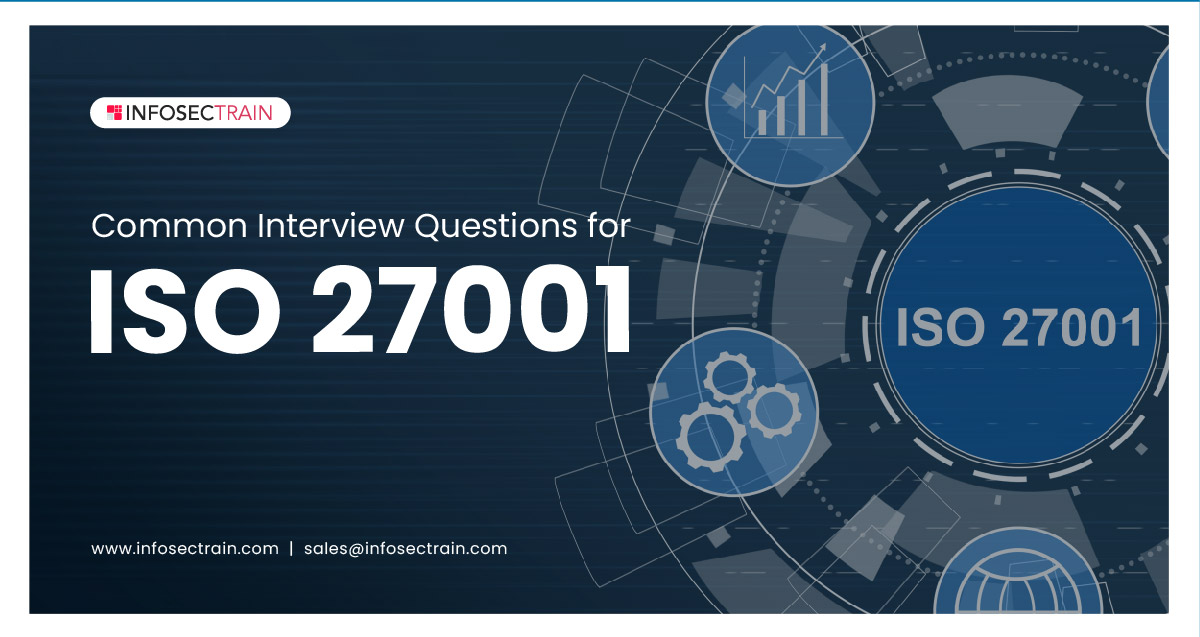Common Interview Questions for ISO 27001
The ISO 27001 certification is a well-recognized certification that helps to implement, maintain, and derive the Information Security Management System (ISMS) best practices of an organization. It adds trust value to the organization’s security posture. This blog is curated with the list of top interview questions and answers for ISO 27001, defined by our experts, which would help you have a quick revision before cracking an interview.

1. Define the importance of ISO 27001 certification.
ISO 27001 is the standard certification recognized globally for adequate information security and management systems. It helps improve security practices and protects the organization’s reputation. The ISO 27001 certification helps to mitigate the financial penalties for non-compliance and losses associated with cyber attacks.
2. What are the steps involved during the implementation of ISO 27001?
The following are the steps involved during the implementation of ISO 27001:
- Define the scope of ISMS
- Develop the policy for Information security
- Execute Gap Analysis
- Identify risk by performing risk assessment
- Develop Risk Treatment Plan
- Documentation and its control
- Employee training program
- Conduct Internal Audit
- Execute Management reviews
- Selection of ISO certification body
3. What are the core principles of Information Security?
The core principles of Information Security are:
- Confidentiality
- Integrity
- Availability
Each element determines the objectives of Information Security.
4. What are the ways to authenticate a person?
The following are the various ways used to authenticate a person:
- Biometric Authentication
- Certificate-based Authentication
- Multi-factor Authentication
- Password-based Authentication
- Token-based Authentication
5. What are the mandatory requirements that organizations need to implement ISO 27001?
Organizations’ mandatory requirements to implement ISO 27001 are defined in clauses 4 to 10. They are as follows:
- Clause 4: The context of the organization
- Clause5: Leadership
- Clause6: Planning
- Clause7: Support
- Clause8: Operation
- Clause9: Performance Evaluation
- Clause10: Improvement
6. Define Risk-based Auditing.
Risk-based auditing is an audit plan designed to address management’s high-priority risks. It allows internal auditors to respond to the risks and provide insights to management to solve risks timely.
7. What are the different types of Audit Risks?
The following are the three different types of Audit Risks:
- Control Risks
- Detection Risk
- Inherent Risk
8. What is the difference between Inherent Risk and Control Risk?
Inherent risk is an error that occurs due to internal control failure, a common error in the financial sector. On the other hand, Control Risk is the possibility of misstated financial statements due to the failure of internal controls.
9. List out the mandatory documents required by ISO 27001.
The following are the mandatory documents defined in Annex A:
- Scope of the ISMS
- Information security policy and objectives
- Risk assessment and risk treatment methodology
- Statement of Applicability
- Risk Treatment Plan
- Risk Assessment Report
- Inventory of Assets
- Access Control Policy
10. What are the stages of an External Audit?
The following are the different stages of an external audit:
- Stage1 Audit: Documentation Review
- Stage2 Audit: Certification Audit
- Stage3 Audit: Surveillance Audit (also referred to as Periodic Audit)
- Stage4 Audit: Recertification Audit
11. Define the ISO 27001 classification of Information.
Information classification is a method in which organizations analyze the collected information and segregate the data regarding the level of protection and confidentiality. Usually, there are four levels of classification:
- Confidential Information
- Restricted Information
- Internal Information
- Public Information
12. Define the Maturity Model.
The Maturity Model is a structured framework used to define the various aspects of the organizations that can provide sustainable and reliable outcomes. It helps measure ISMS’s effectiveness and continuous improvements at multiple levels.
13. What are the different levels of maturity models?
The following are the different levels of maturity models defined in ISO standards:
- Incomplete
- Performed
- Managed
- Established
- Predictable
- Optimized
14. What are the different phases of the ISMS Maturity Assessment Methodology?
The following are the different phases of the ISMS Maturity Assessment Methodology:
- Assessment Initiation
- Appointing as assessment team
- Assessment tool creation
- Document review
- Evaluation and recommendations
- Reporting
15. What are the objectives of security policies?
The following are the various objectives of security policies:
- To protect the organization’s resources from security threats
- To prevent unauthorized access to data
- To limit the user access right based on the hierarchical levels
- To maintain a framework for the administration and management of network security
- To protect proprietary and confidential data from theft and misuse
16. Define security policy and mention the types of security policies.
The security policy is a document that includes the organization’s data security plan designed and implemented to protect the data assets from known or unknown threats.
The security policies are classified into four forms:
- Promiscuous Policy
- Prudent Policy
- Permissive Policy
- Paranoid Policy
17. What are the adequate steps of ISO 27001 risk assessment?
The following are the adequate step of ISO 27001 risk assessment:
- Define the risk assessment method
- Compile the list of information assets
- Identify the threats and vulnerabilities
- Evaluate risks
- Mitigate risks
- Develop risk reports
- Review, monitor, and audit
18. What is a Risk Assessment Report?
The Risk Assessment Report (RAR) is a standard report that includes risk assessment outcomes. It consists of the findings and action plan derived from assessing the organization’s risks.
The Risk assessment reports are of two types:
- Statement of Applicability
- Risk Treatment Plan
ISO 27001 Foundation with InfosecTrain
InfosecTrain is a well-known training provider for a wide range of Cybersecurity and Information security domains. It provides the ISO 27001 Lead Auditor and ISO 27001 Lead Implementer online certification training program that helps to understand the best practices for implementing ISMS. To get certified, check out and enroll now.
TRAINING CALENDAR of Upcoming Batches For ISO 27001 : 2022 LA
| Start Date | End Date | Start - End Time | Batch Type | Training Mode | Batch Status | |
|---|---|---|---|---|---|---|
| 11-May-2024 | 09-Jun-2024 | 19:00 - 23:00 IST | Weekend | Online | [ Open ] | |
| 22-Jun-2024 | 28-Jul-2024 | 09:00 - 13:00 IST | Weekend | Online | [ Open ] |
TRAINING CALENDAR of Upcoming Batches For ISO 27001:2022 LI
| Start Date | End Date | Start - End Time | Batch Type | Training Mode | Batch Status | |
|---|---|---|---|---|---|---|
| 25-May-2024 | 16-Jun-2024 | 09:00 - 13:00 IST | Weekend | Online | [ Open ] |





 1800-843-7890 (India)
1800-843-7890 (India) 
